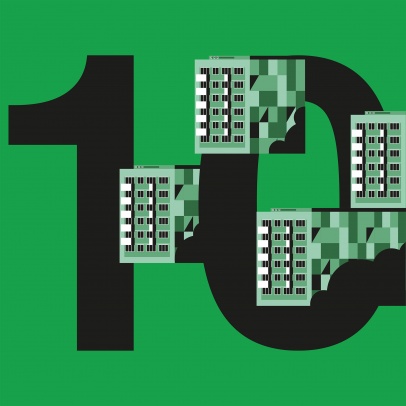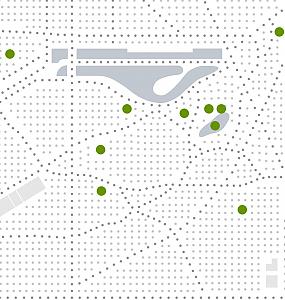The Sculpture Park. Chapter X
The Venice Bródno Biennale
The tenth installment of the Bródno Sculpture Park takes the form of a biennale: over the course of ten days, from June 23 to July 1, 2018, the entire neighborhood of Bródno will become one large art exhibition. Rather than being presented with a finished, tangible work of art, however, viewers are given a conceptual “model kit” to assemble themselves, a display in which the map is the territory.
The collaborative artist duo Paweł Althamer and Goshka Macuga proposed that Warsaw’s Bródno neighborhood be nominated as an exhibition, citing the biennale format famously used in cities such as São Paulo, Berlin, and Istanbul. Althamer and Macuga focus on on the neighborhood’s defining features: the situations, sites, local initiatives, inventions, collections, buildings, and the infrastructure that can be encountered here. They call it a “Venice” biennale, alluding to the world’s oldest (established in 1895) and most famous art event held on a biennial basis. This descriptor also emphasizes the splendor and solemnity inherent in the very act of considering the neighborhood in terms of an art exhibition. The exhibition is a tool for shaping public awareness, and can therefore be a means for social change.
The map of the exhibition features over eighty locations that were selected this spring while touring Bródno in the company of local experts. Locals were also encouraged to submit their own ideas: postcards calling on resident to participate — “Show Bródno to the World!” — were deposited in mailboxes all across Bródno. The collaboratively designed program for the Venice Biennale in Bródno is just one of many possible itineraries for exploring the neighborhood. The purpose of the exhibition is not to create an idealized, sentimental depiction of Bródno, but rather to present a subjectively composed constellation of things that would introduce audiences to the spirit of the place, its ongoing transformation, the co-existence of its numerous seemingly incompatible elements, defects, and traces of past social and urban processes.
The biennale sites have been grouped around four paths leading into the neighborhood, thus forming “themed routes” along which to experience the exhibition: the necropolis (south entrance: Bródno Cemetery), the mysterious object (starting in the middle of the neighborhood: Bródno Park), transportation (west entrance: “Railside” Bródno), and nature (northeast entrance: Bródno Forest). Each of these routes serve as a themed “tunnel” that draws our attention to particular phenomena in the neighborhood, while leaving room for the exhibition to encompass areas beyond the district limits of Bródno.
The Bródno Biennale is a catalog of the “local” themes running through Paweł Althamer’s own art. The artist uses art as a tool for discovering the surreal and mystical nature of objects in the world around him. For his 1997 “Bródno” exhibition at the Tęcza Cinema’s A.R. Gallery, Althamer assembled objects he had found in his neighborhood or had been created or modified by his neighbors. The artist has also consistently employed “the drift” (dérive), or walking, as a medium, exploring the world through the eyes of a newcomer, an astronaut, or a member of “another tribe.” He refers to his artistic practice as “directing reality,” and describes its outcome as a “film in real time.”
Goshka Macuga, meanwhile, is more analytical in her work methods, and uses what is known as “cultural archeology”: she precedes each new project with exhaustive archival work that place her pieces within a broader context, such as that of the economic factors involved in art. Macuga employs both artistic and curatorial techniques, creating installations that incorporate the work of other artists, archival materials, and found objects. Both artists make subtle and often have made imperceptible “editorial changes” in selected sites featured in the Biennale. But their role, for the most part, is like that of theater or film directors; they work with a larger team that is tasked with preparing and editing the material about Bródno, making it available to the public in the form of an exhibition. It includes many of the neighborhood’s found elements: store windows, school playgrounds, holes in the ground, faucets, marketplaces, empty lots, architectural details, and even the interiors of businesses and private apartments. The Venice Biennale in Bródno also uses the traditional elements found in the modern-day museologist’s toolkit, such as catalogs, labels, guided tours, and maps, all of which enable us to emphasize certain objects and events and abstract them from their surroundings. Deciding which objects to see, and in what order, is left to the viewers, who are given a map and catalog. Throughout the Biennale, the Museum of Modern Art in Warsaw will provide guided tours with museum staff who are professionally involved in contemporary art education and popularization, and with local experts who live in Bródno. The “Central Pavilion” will be located at the Tea House, a sculpture by Rikrit Tirivanija in Bródno Park, and will serve as an information point, a meeting place, and a distribution center for Biennale items and printed matter. The steward of this venue is the artist Michał Mioduszewski, who in 2010 came up with the idea to turn the sculpture into “Warsaw’s smallest cultural center.” The park is also home to the Orangery, a community greenhouse that opens during the spring and summer months and will serve as a venue for the Biennale’s accompanying events, hosted by the community animator Iza Kaszyńska.
The activities that have taken place at the Bródno Sculpture Park over the past few years form a natural sequence of events: we believe that art is increasingly becoming a part of everyday life for the park’s neighbors and visitors, who have planted oak trees together, helped revitalize a garden-sculpture, enjoyed picnics by the Tea House, gathered stones during aimless walks, etc.
To experience Bródno on a scale of 1:1, as it is, unretouched and with no idealization, is the purpose of this year’s edition of the Sculpture Park. The accompanying book is a set of instructions that will help readers explore the Biennale, an exhibition that “uses the country itself, as its own map.”
The program of this anniversary edition also features a collaboration with our sister institution, the Srihatta Art Centre and Sculpture Park, run by the Samdani Art Foundation in Sylhet, Bangladesh. The park opened in 2016 with an inaugural installation by Paweł Althamer, titled Rokeya. The Bangladesh National Pavilion will be installed in Bródno during the Biennale.
Sebastian Cichocki, May 2018
Artists
Paweł Althamer, Goshka Macuga
Curators
Sebastian Cichocki, Iza Kaszyńska
In cooperation with
Michał Mioduszewski
Central Pavilion, architecture
Tomasz Świetlik
Production
Aleksandra Nasiorowska, Aniela Trojanowska
Project manager
Julia Kern-Protassewicz
Visual identity
Ola Jasionowska
“The Sculpture Park is in Bródno” Education Program
Iza Kaszyńska, Marta Maliszewska, Marta Skowrońska-Markiewicz
Volunteer coordinator
Dominika Jagiełło
Publication accompanying the 10th edition of the Bródno Sculpture Park
Authors: Olga Byrska, Sebastian Cichocki
Research: Aniela Trojanowska
Translation: Arthur Barys
Editing and proofreading: Meagan Down, Kacha Szaniawska
Design: Ola Jasionowska
Photography: Wojtek Radwański
Managing editor: Kacha Szaniawska
The following people were involved in selecting locations for the Venice Biennale in Bródno, conducting tours/site-visits, and collecting stories from local guides in February–May 2018:
Vicinity of the pedestrian bridge between the FSO Auto Plant and Bródno, and the neighborhood of Golędzinowska Street: Michał Mioduszewski
“Railside” Bródno: Bartosz Wieczorek
Quarter bounded by the Toruń Highway and Mother Teresa of Calcutta Street; Toruńska and Kondratowicz housing complexes: Jolanta Zientek-Varga
Pekin and the surrounding area: Robert Goliński
Podgrodzie housing complex, Bródno Forest, Bolivar housing complex: Filip Popiółkowski
Wild parts of “Railside” Bródno: Mateusz Kowalczyk
Promotion and communication
Iga Winczakiewicz, Anna Tryc, Kacha Szaniawska
Photography
Wojtek Radwański, Tomasz Kaczor
Installation
Iga Winczakiewicz, Anna Tryc, Kacha Szaniawska
Orangery, community animator
Iza Kaszyńska
Orangery, production
Fundacja Transformacja
Acknowledgements
Magdalena Anyszewska (Targówek City Hall), Ewa Ayton (British Council),
Robert Czajka, Krzysztof Pyda, Mirosław Wróbel, Bogdan Zieliński, Dariusz Żukowski (AG Complex)
and:
for their contributions to “The Sculpture Park is in Bródno” program:
Academic Reading Room No. 1 at the Targówek Public Library, Świt Cultural Center, the Pizza Cafe Camelot Pub, the Matejko Youth Club
participants of “The Sculpture Park is in Bródno” program:
Agnieszka Jaglarska, Mateusz Kowalczyk, Małgorzata Olejniczak, Małgorzata Podgórska Manowska, Paulina Śledziak, Bernard Wnuk, Piotr Zając, Jolanta Zientek-Varga;
”Show Bródno to the World” ideas and proposals:
Bruno Althamer, Diana Grabowska, Michał Mioduszewski, Bartosz Wieczorek, Monika and Marcin Zambrzycki, Dariusz Żukowski
exhibition pavilions:
Bangladesh Pavilion | Diana Campbell Betancourt, Nadia and Rajeeb Samdani (Samdani Art Foundation)
Belarus Pavilion | Julia Matea Petelska-Athamer, Dariusz Żukowski

